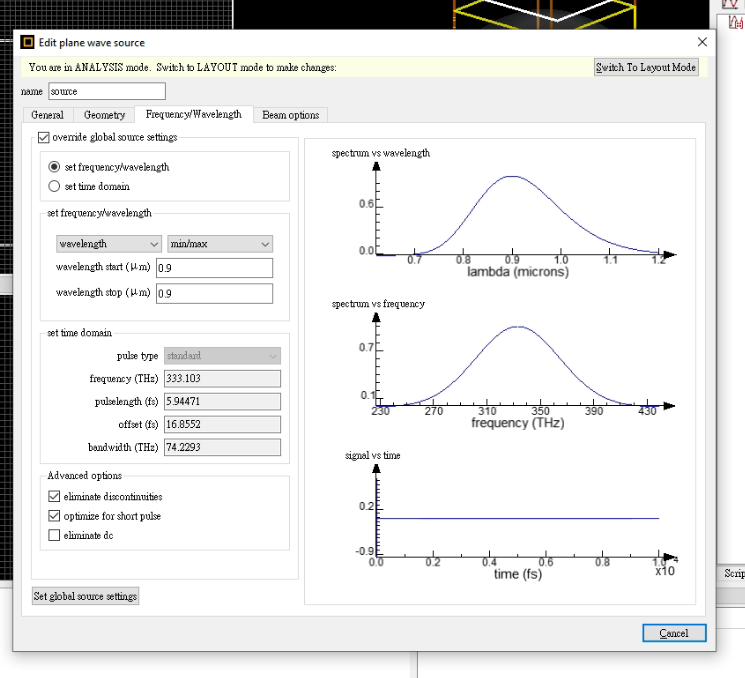-
-
March 1, 2022 at 5:31 am
r09941129
Subscriber分别对两种情况进行了单波长运行 source设置为900nm 结构为一个透镜加硅基板
March 2, 2022 at 12:57 amGuilin Sun
Ansys Employee主要问题是,当你把光源设置为单波长时,其它波长的强度就可能很弱了,你看看0.4微米的地方是不是很低?你设置为单波长光源就意味着你不需要其它波长的结果。如果需要其它波长的结果,光源就要设置为宽谱。
此结果也显示了这样一个道理:如果某波长的入射强度很低,其信号就很弱,相对于强波长,其结果就不可靠,相当于噪音一样。
也就是说,要宽谱就要用宽谱光源,不能用单波长。至于两种设置的差别,很可能是光源、或者材料拟合等不同。March 2, 2022 at 10:31 amr09941129
Subscriber感觉解释的并不是很清楚 扫描波长难道不是只用sweep去扫单波长吗 还是案例中的扫描波长只是只扫描款变频 而且我光源设置的是0.9微米 不管是0.4还是0.5其实可以看到都远大于1 我只要看0.9的结果 很显然并看不到March 2, 2022 at 4:37 pmGuilin Sun
Ansys Employee我也不清楚你的问题到底是什么?你说“分别对两种情况进行了单波长运行 source设置为900nm”,也就是在固定光源单波长的情况下,你得到不同波长的结果,所以才有上述解释。
你光源什么入射角度?斜入射吗?用的什么边界条件? “案例中的扫描波长只是只扫描款变”当然啊,要不然什么叫扫描波长啊?
“且我光源设置的是0.9微米 不管是0.4还是0.5其实可以看到都远大于1 ”
你用0.9微米的光源为什么看0.4还是0.5微米的结果?
“我只要看0.9的结果 很显然并看不到”我不知道你为什么看不到,你没有说明整个过程我无法回答。
正确的波长扫描是:
斜入射情况,设置你说的两种方法之一,用Bloch边界条件,根据入射角和可能的最大衍射角选择合适的PML,确保仿真时间足够,到达 autoshutoff min 才结束仿真,扫描光源波长,每次提取光源波长的结果。如果违反任何其中一条都需要修正。
参考 Understanding injection angles in broadband simulations
注意,这个例子是为零节省时间,同时得到不同波长不同角度的结果 https://support.lumerical.com/hc/en-us/articles/1500006417822-Bloch-BCs-in-broadband-sweeps-over-angle-of-incidence 结果需要再插值,你不要用这个例子。
Viewing 3 reply threads- The topic ‘有关于“Ansys Insight: 扫描波长时如何设置网格、材料拟合和监视器”疑问’ is closed to new replies.
Ansys Innovation SpaceTrending discussionsTop Contributors-
3647
-
1313
-
1142
-
1075
-
1013
Top Rated Tags© 2025 Copyright ANSYS, Inc. All rights reserved.
Ansys does not support the usage of unauthorized Ansys software. Please visit www.ansys.com to obtain an official distribution.
-
The Ansys Learning Forum is a public forum. You are prohibited from providing (i) information that is confidential to You, your employer, or any third party, (ii) Personal Data or individually identifiable health information, (iii) any information that is U.S. Government Classified, Controlled Unclassified Information, International Traffic in Arms Regulators (ITAR) or Export Administration Regulators (EAR) controlled or otherwise have been determined by the United States Government or by a foreign government to require protection against unauthorized disclosure for reasons of national security, or (iv) topics or information restricted by the People's Republic of China data protection and privacy laws.












